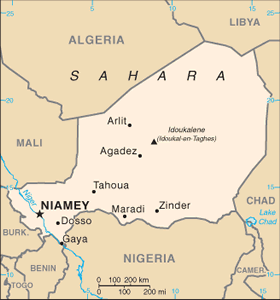The Geography of Niger
The Geography of Niger
Nigerien Geography
Location: Western Africa, southeast of Algeria
Geographic coordinates: 16 00 N, 8 00 E
Map references: Africa
Area: total: 1.267 million sq km land: 1,266,700 sq km water: 300 sq km
Area - comparative: slightly less than twice the size of Texas
Land boundaries: total: 5,697 km border countries: Algeria 956 km, Benin 266 km, Burkina Faso 628 km, Chad 1,175 km, Libya 354 km, Mali 821 km, Nigeria 1,497 km
Coastline: 0 km (landlocked)
Maritime claims: none (landlocked)
Climate: desert; mostly hot, dry, dusty; tropical in extreme south
Terrain: predominately desert plains and sand dunes; flat to rolling plains in south; hills in north
Elevation extremes: lowest point: Niger River 200 m highest point: Mont Bagzane 2,022 m
Natural resources: uranium, coal, iron ore, tin, phosphates, gold, molybdenum, gypsum, salt, petroleum
Land use: arable land: 11.43% permanent crops: 0.01% other: 88.56% (2005)
Irrigated land: 730 sq km (2003)
Natural hazards: recurring droughts
Environment - current issues: overgrazing; soil erosion; deforestation; desertification; wildlife populations (such as elephant, hippopotamus, giraffe, and lion) threatened because of poaching and habitat destruction
Environment - international agreements: party to: Biodiversity, Climate Change, Climate Change-Kyoto Protocol, Desertification, Endangered Species, Environmental Modification, Hazardous Wastes, Ozone Layer Protection, Wetlands signed, but not ratified: Law of the Sea
Geography - note: landlocked; one of the hottest countries in the world; northern four-fifths is desert, southern one-fifth is savanna, suitable for livestock and limited agriculture


